
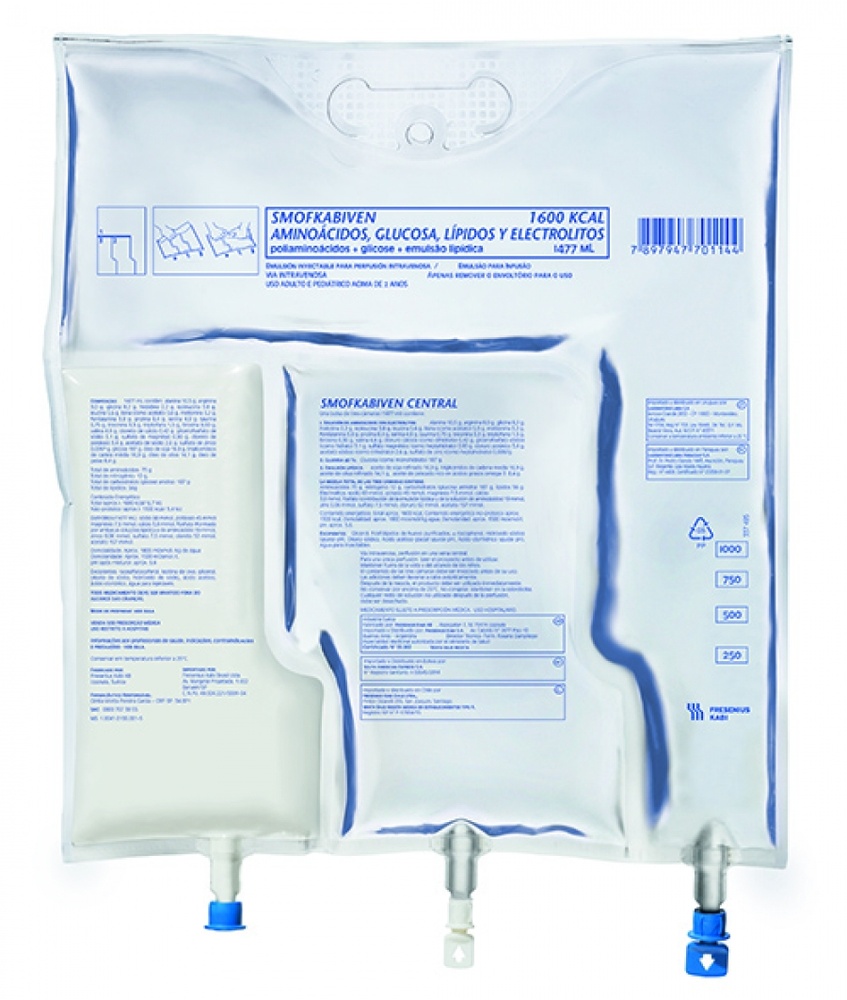
SMOFKABIVEN WITHOUT ELECTROLYTES CENTRAL EMULSION FOR INFUSION

Ask a doctor about a prescription for SMOFKABIVEN WITHOUT ELECTROLYTES CENTRAL EMULSION FOR INFUSION

How to use SMOFKABIVEN WITHOUT ELECTROLYTES CENTRAL EMULSION FOR INFUSION
Introduction
Package Leaflet: Information for the User
SmofKabiven without Electrolytes Central Emulsion for Infusion
Read all of this leaflet carefully before you start using this medicine, because it contains important information for you.
- Keep this leaflet, you may need to read it again.
- If you have any further questions, ask your doctor, pharmacist, or nurse.
- If you experience any side effects, talk to your doctor, pharmacist, or nurse, even if they are not listed in this leaflet. See section 4.
Contents of the package leaflet:
- What SmofKabiven without Electrolytes Central is and what it is used for
- What you need to know before you start using SmofKabiven without Electrolytes Central
- How to use SmofKabiven without Electrolytes Central
- Possible side effects
- Storage of SmofKabiven without Electrolytes Central
- Contents of the pack and further information
1. What SmofKabiven without Electrolytes Central is and what it is used for
SmofKabiven without Electrolytes Central is an emulsion for infusion that is administered into your blood through a drip (intravenous infusion). The product contains amino acids (components used in the formation of proteins), glucose (carbohydrates), and lipids (fat), in a plastic bag, and can be administered to adults and children from 2 years of age.
A healthcare professional will administer SmofKabiven without Electrolytes Central to you when other forms of nutrition are not sufficient or not possible.
2. What you need to know before you start using SmofKabiven without Electrolytes Central
Do not use SmofKabiven without Electrolytes Central:
-if you are allergic (hypersensitive) to the active substances or to any of the other components of this medicine (listed in section 6).
-if you are allergic to fish or egg
-if you are allergic to peanuts or soy, you should not use this product. SmofKabiven without Electrolytes Central contains soybean oil.
-if you have too much fat in your blood (hyperlipidemia)
-if you have severe liver disease
-if you have blood coagulation problems (coagulation disorders)
-if your body has problems using amino acids
-if you have severe kidney disease without the possibility of dialysis
-if you are in acute shock
-if you have too much sugar in your blood (hyperglycemia) that is not controlled
-if you have fluid in your lungs (acute pulmonary edema)
-if you have too much fluid in your body (overhydration)
-if you have heart failure that is not being treated
-if you have a defect in your blood coagulation system (hemophagocytic syndrome)
-if you are in an unstable situation, such as after severe trauma, uncontrolled diabetes mellitus, acute heart attack, stroke, blood clot, metabolic acidosis (a condition that leads to too much acid in your blood), severe infection (sepsis), coma, and if you do not have enough fluid in your body (hypotonic dehydration).
-in children under 2 years of age.
Warnings and precautions
Talk to your doctor before starting to use SmofKabiven without Electrolytes Central if you have:
kidney problems
diabetes mellitus
pancreatitis (inflammation of the pancreas)
liver problems
hypothyroidism (thyroid problems)
sepsis (severe infection)
If during the infusion you experience fever, rash, swelling, difficulty breathing, chills, sweating, nausea, or vomiting, inform your healthcare professional immediately, because these symptoms could be caused by an allergic reaction or because you are receiving too much of the medicine.
Your doctor will need to regularly check your blood to monitor liver function tests and other values.
Children and adolescents
SmofKabiven without Electrolytes Central is not intended for newborns or children under 2 years of age. SmofKabiven without Electrolytes Central may be administered in children from 2 to 16/18 years of age.
Using SmofKabiven without Electrolytes Central with other medicines
Tell your doctor if you are taking, have recently taken, or might take any other medicines, including those obtained without a prescription.
Pregnancy and breastfeeding
There is no information on the use of SmofKabiven without Electrolytes Central during pregnancy or breastfeeding. Therefore, SmofKabiven without Electrolytes Central should only be administered to pregnant or breastfeeding women if the doctor considers it necessary. However, the use of SmofKabiven without Electrolytes Central may be considered during pregnancy and breastfeeding if your doctor advises it.
Driving and using machines
This is not relevant, as this medicine is administered in the hospital.
3. How to use SmofKabiven without Electrolytes Central
Follow exactly the administration instructions of this medicine given by your doctor. In case of doubt, consult your doctor again.
Your doctor will decide the dose for you individually, depending on your body weight and situation. SmofKabiven without Electrolytes Central will be administered to you by a healthcare professional.
If you use more SmofKabiven without Electrolytes Central than you should
It is very unlikely that you will receive too much of the medicine, as SmofKabiven without Electrolytes Central will be administered by a healthcare professional.
4. Possible side effects
Like all medicines, SmofKabiven without Electrolytes Central can cause side effects, although not everybody gets them.
Common(may affect up to 1 in 10 people): a slight increase in body temperature.
Uncommon(may affect up to 1 in 100 people): elevated levels in blood (plasma) of liver components, loss of appetite, nausea, vomiting, chills, dizziness, and headache.
Rare(may affect up to 1 in 1000 people): low or high blood pressure, difficulty breathing, rapid heart rate (tachycardia). Hypersensitivity reactions (which can cause symptoms such as swelling, fever, drop in blood pressure, skin rash, hives, redness, headache). Feelings of cold and heat. Paleness. Lips and skin with bluish discoloration (due to lack of oxygen in your blood). Pain in the neck, back, bones, chest, and lumbar region.
Reporting of side effects
If you experience any side effects, talk to your doctor, pharmacist, or nurse, even if they are not listed in this leaflet. You can also report side effects directly through the Spanish Pharmacovigilance System for Human Use Medicines: https://www.notificaram.es. By reporting side effects, you can help provide more information on the safety of this medicine.
5. Storage of SmofKabiven without Electrolytes Central
Keep this medicine out of the sight and reach of children. Store in the outer bag. Do not store above 25°C. Do not freeze.
Do not use this medicine after the expiry date which is stated on the bag and carton. The expiry date is the last day of the month stated.
6. Container Content and Additional Information
SmofKabiven without Electrolites Central Contains
The active substances areg per 1000 ml
Alanine 7.1
Arginine 6.1
Glycine 5.6
Histidine 1.5
Isoleucine 2.5
Leucine 3.8
Lysine (as acetate) 3.4
Methionine 2.2
Phenylalanine 2.6
Proline 5.7
Serine 3.3
Taurine 0.5
Threonine 2.2
Tryptophan 1.0
Tyrosine 0.20
Valine 3.1
Glucose (as monohydrate) 127
Soybean oil, refined 11.4
Medium-chain triglycerides 11.4
Olive oil, refined 9.5
Fish oil, rich in omega-3 fatty acids 5.7
The other ingredients are: glycerol, purified egg phospholipids, all-rac-α-tocopherol, sodium hydroxide (pH adjustment), sodium oleate, acetic acid (pH adjustment), hydrochloric acid (pH adjustment), and water for injectables.
Appearance of the Product and Container Content
The glucose and amino acid solutions are clear, colorless or slightly yellow, and particle-free. The lipid emulsion is white and homogeneous.
Container Sizes:
1 x 493 ml, 6 x 493 ml
1 x 986 ml, 4 x 986 ml
1 x 1.477 ml, 4 x 1.477 ml
1 x 1.970 ml, 4 x 1.970 ml
1 x 2.463 ml, 3 x 2.463 ml
Marketing Authorization Holder and Manufacturer
Holder:
Fresenius Kabi España S.A.U. C/ Marina 16-18,
08005 Barcelona (Spain)
Manufacturer:
Fresenius Kabi AB, SE-751 74 Uppsala, Sweden
or
Fresenius Kabi Austria GmbH, AT-8055 Graz, Austria
Date of the Last Revision of this Leaflet:January 2023
Detailed and updated information on this medicinal product is available on the website of the Spanish Agency for Medicines and Health Products (AEMPS) http://www.aemps.gob.es/
?-------------------------------------------------------------------------------------------------------------------------
This information is intended only for healthcare professionals:
Special Warnings and Precautions for Use
To avoid the risks associated with too rapid infusion rates, it is recommended to use continuous and well-controlled infusion, if possible using an infusion pump.
Since the use of a central vein is associated with a high risk of infection, strict aseptic precautions should be taken to avoid any contamination during catheter insertion and handling.
Glucose, electrolytes, and osmolarity, as well as fluid balance, acid-base balance, and liver enzyme tests, should be monitored.
In case of any signs or symptoms of anaphylactic reaction (such as fever, shivering, skin rash, or dyspnea), the infusion should be interrupted immediately.
SmofKabiven without Electrolites Central should not be administered simultaneously with blood in the same infusion equipment due to the risk of pseudoagglutination.
Method of Administration
Intravenous route, infusion in a central vein.
To provide complete parenteral nutrition, the following should be added to SmofKabiven without Electrolites Central: trace elements, electrolytes, and vitamins, according to the patient's needs.Dosage
Adults
Dosage: The dose range of 13-31 ml SmofKabiven without Electrolites Central/kg body weight/day will provide 0.6-1.6 g of amino acids/kg body weight/day (corresponding to 0.10-0.25 g nitrogen/kg body weight/day) and 14-35 kcal/kg body weight/day of total energy (12-27 kcal/kg body weight/day of non-protein energy).
 Infusion Rate
Infusion Rate
The maximum infusion rate for glucose is 0.25 g/kg body weight/h, for amino acids 0.1 g/kg body weight/h, and for lipids 0.15 g/kg body weight/h.
The infusion rate should not exceed 2.0 ml/kg body weight/hour (corresponding to 0.25 g of glucose, 0.10 g of amino acids, and 0.08 g of lipids/kg body weight/h). The recommended infusion period is 14-24 hours.
Maximum Daily Dose: The maximum daily dose varies with the patient's clinical situation and may even change from day to day. The recommended maximum daily dose is 35 ml/kg body weight/day.
Pediatric Population
Children (2-11 years)
Dosage:
The dose of up to 35 ml/kg body weight/day should be adjusted regularly according to the pediatric patient's requirements, which vary more than in adult patients.
Infusion Rate:
The maximum infusion rate is 2.4 ml/kg body weight/h (corresponding to 0.12 g of amino acids/kg/h, 0.30 g/glucose/kg/h, and 0.09 g lipids/kg/h). At the maximum recommended infusion rate, do not use infusion periods longer than 14 hours and 30 minutes, except in exceptional cases and under close monitoring.
The recommended infusion period is 12-24 hours.
Maximum Daily Dose: The maximum daily dose varies with the patient's clinical condition and may even change from day to day. The maximum daily dose is 35 ml/kg body weight/day.
Adolescents (12-16/18 years)
SmofKabiven Central can be used in adolescents in the same way as in adults.
Precautions for Use
Do not use the container if it is damaged.
Use only if the amino acid and glucose solutions are clear, colorless, or slightly yellow, and if the lipid emulsion is white and homogeneous. The contents of the three separate chambers should be mixed before use, and before making any additions through the additive port. After opening the peel-type seals, the bag should be inverted several times to ensure a homogeneous mixture, which does not show evidence of phase separation.
For single use. Any leftover mixture should be discarded after infusion.
Compatibility
There are compatibility data with defined quantities of the proprietary products Dipeptiven 200 mg/ml, Supliven, Glycophos 216 mg/ml, Vitalipid Adult/Infant, and Soluvit lyophilized and generic electrolytes in defined concentrations. When adding electrolytes, the quantities already present in the bag should be taken into account to meet the patient's clinical needs. The generated data support the additions to the activated bag according to the summary table shown below:
Stability range established for 8 days, i.e., 6 days of storage at 2-8°C followed by 48 hours at 20-25°C
Units | Total Maximum Content | |||||
Size of SmofKabiven without Electrolites bag | ml | 493 | 986 | 1477 | 1970 | 2463 |
Additive | Volume | |||||
Dipeptiven | ml | 0-100 | 0 - 300 | 0 - 300 | 0 - 300 | 0 - 300 |
Supliven | ml | 0 - 10 | 0 - 10 | 0 - 10 | 0 - 10 | 0 - 10 |
Soluvit | vial | 0 - 1 | 0 - 1 | 0 - 1 | 0 - 1 | 0 - 1 |
Vitalipid Adult/Infant | ml | 0 - 10 | 0 - 10 | 0 - 10 | 0 - 10 | 0 - 10 |
Electrolyte Limits1 | Quantity per Bag | |||||
Sodium | mmol | ≤ 75 | ≤ 150 | ≤ 225 | ≤ 300 | ≤ 375 |
Potassium | mmol | ≤ 75 | ≤ 150 | ≤ 225 | ≤ 300 | ≤ 375 |
Calcium | mmol | ≤ 2.5 | ≤ 5 | ≤ 7.5 | ≤ 10 | ≤ 12.5 |
Magnesium | mmol | ≤ 2.5 | ≤ 5 | ≤ 7.5 | ≤ 10 | ≤ 12.5 |
Organic Phosphate (Glycophos)2 | mmol | ≤ 7.5 | ≤ 15 | ≤ 22.5 | ≤ 30 | ≤ 37.5 |
Zinc | mmol | ≤ 0.1 | ≤ 0.2 | ≤ 0.25 | ≤ 0.3 | ≤ 0.35 |
Selenium | µmol | ≤ 1 | ≤ 1 | ≤ 1 | ≤ 1 | ≤ 1.15 |
1includes the quantities of all products.
2 The additions of Glycophos can be doubled with a stability of 7 days, i.e., 6 days of storage at 2-8°C followed by 24 hours at 20-25°C.
Note: This table is intended to indicate compatibility. It is not a dosage guide.
In the case of proprietary products, before prescribing them, consult the approved technical sheet.
There are data on compatibility with other additives and the shelf life of the different mixtures, available upon request.
Additions should be made aseptically.
Validity Period after Mixing the Bag Chambers
The physical and chemical stability of the mixed three-chamber bag has been demonstrated for 48 hours at 20-25°C. From a microbiological point of view, the product should be used immediately. If not used immediately, the storage time until use and the conditions prior to use are the responsibility of the user and should not normally exceed 24 hours at 2-8°C, unless the mixture has been made under controlled and validated aseptic conditions.
Validity Period after Mixing with Additives
Physicochemical stability in use of the mixed three-chamber bag with additives has been demonstrated for up to 8 days, i.e., 6 days at 2-8°C followed by 48 hours at 20-25°C, including the duration of administration. From a microbiological point of view, the product should be used immediately after making the additions. If not used immediately, the storage time until use and the conditions prior to use are the responsibility of the user. The storage time should not normally exceed 24 hours at 2-8°C, unless the mixture has been made under controlled and validated aseptic conditions.
Instructions for the Use of SmofKabiven without Electrolites Central
The Bag
- 493 ml 986 ml, 1477 ml, 1970 ml, 2463 ml
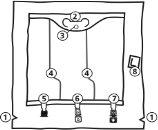
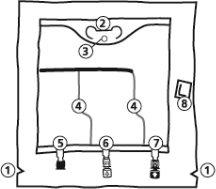
- Notches on the overbag
- Hanger
- Hanger ring for hanging the bag
- Peel seals
- Port without outlet (only used during manufacturing)
- Additive port
- Infusion port
- Oxygen absorber
- Removal of the overbag
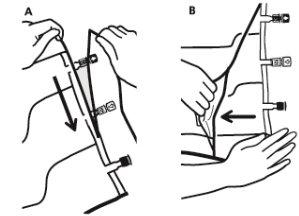
- To remove the overbag, hold it in a horizontal position and tear along the notch towards the ports along the top edge (A).
- Then, simply tear along the container; separate the overbag and discard it along with the oxygen absorber (B).
- Mixing
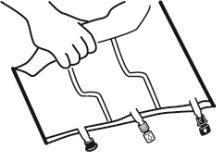
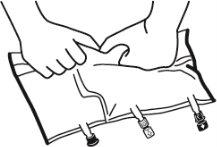
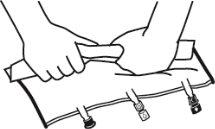
- Place the bag on a flat surface.
- Roll the bag from the hanger part towards the port part, first with the right hand and then applying constant pressure with the left hand until the vertical seals have opened. The vertical peel seals open due to the liquid pressure. The peel seals can also be opened before removing the overbag.
Note:the liquids mix easily even if the horizontal seal remains closed.
493 ml, 986 ml, 1477 ml, 1970 ml, 2463 ml
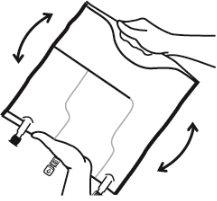
- Mix the contents of the three chambers by inverting the bag three times until the components are completely mixed.
- Final Preparation
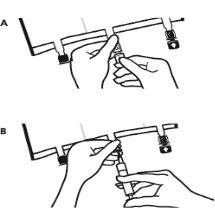
- Place the bag back on a flat surface. Just before injecting the additives, break the white additive port by the arrow mark (A).
Note:The additive port membrane is sterile
- Hold the base of the additive port. Insert the needle, inject the additives (of known compatibility) through the center of the injection point (B).
- Mix completely between each addition, inverting the bag three times. Use syringes with 18-23 gauge needles and a maximum length of 40 mm.
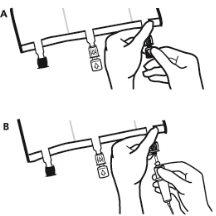
- Just before inserting the infusion set, break the blue infusion port by the arrow mark (A).
Note:The infusion port membrane is sterile
- Use non-vented infusion equipment or close the air inlet of the vented equipment.
- Hold the base of the infusion port.
- Introduce the spike through the infusion port. The spike should be fully inserted to ensure its retention.
Note:The inside of the infusion port is sterile
- Hanging the Bag
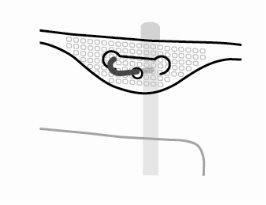
- Hang the bag by the ring under the hanger.
- Country of registration
- Active substance
- Prescription requiredYes
- Manufacturer
- This information is for reference only and does not constitute medical advice. Always consult a licensed doctor before taking any medication. Oladoctor is not responsible for medical decisions based on this content.
- Alternatives to SMOFKABIVEN WITHOUT ELECTROLYTES CENTRAL EMULSION FOR INFUSIONDosage form: INJECTABLE PERFUSION, 3.92 g / 1.26 g / 7.21 g / 3.36 g / 4.2 g / 5.11 g / 2.94 g / 2.8 g / 4.76 g / 5.07 g / 4.06 g / 14.49 g / 0.28 g / 8.05 g / 3.5 g / 200 gActive substance: combinationsManufacturer: Baxter S.L.Prescription requiredDosage form: INJECTABLE INFUSION, 3.5 g / 200 g / 5.22 g / 1.88 g / 3.92 g / 1.26 g / 7.21 g / 3.36 g / 4.2 g / 5.11 g / 2.94 g / 2.8 g / 662 mg / 1.02 g / 4.76 g / 5.15 g / 5.07 g / 4.06 g / 14.49 g / 0.28 g / 8.05 gActive substance: combinationsManufacturer: Baxter S.L.Prescription requiredDosage form: INJECTABLE PERFUSION, 4.25 g / 300 g / 5.22 g / 1.54 g / 4.76 g / 1.53 g / 8.76 g / 4.08 g / 5.1 g / 6.2 g / 3.57 g / 3.4 g / 662 mg / 1.02 g / 5.78 g / 5.94 g / 6.16 g / 4.93 g / 17.6 g / 0.34 g / 9.78 gActive substance: combinationsManufacturer: Baxter S.L.Prescription required
Alternatives to SMOFKABIVEN WITHOUT ELECTROLYTES CENTRAL EMULSION FOR INFUSION in other countries
The best alternatives with the same active ingredient and therapeutic effect.
Alternative to SMOFKABIVEN WITHOUT ELECTROLYTES CENTRAL EMULSION FOR INFUSION in Poland
Alternative to SMOFKABIVEN WITHOUT ELECTROLYTES CENTRAL EMULSION FOR INFUSION in Ukraine
Online doctors for SMOFKABIVEN WITHOUT ELECTROLYTES CENTRAL EMULSION FOR INFUSION
Discuss dosage, side effects, interactions, contraindications, and prescription renewal for SMOFKABIVEN WITHOUT ELECTROLYTES CENTRAL EMULSION FOR INFUSION – subject to medical assessment and local rules.














